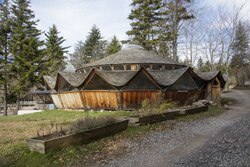Organization:The Mountain Institute
 | |
 | |
| Founded | Cherry Grove, WV, 1972 |
|---|---|
| Founders | Daniel C. Taylor, King Seegar, & Lila Bishop |
| Headquarters | Washington, D.C. |
Area served | The Andean, Appalachian, Himalayan, and other Mountain Ranges |
| Website | www |
The Mountain Institute (TMI) is an international non-profit organization headquartered in Washington, D.C., and operates regional field offices in the Andes,[1] Appalachians,[2] and Himalayas.[3] Respectively, these are the longest, the oldest, and the tallest mountain ranges in the world. TMI is the sole organization dedicated to conservation and development in mountain regions.[4]
History
The Mountain Institute was founded in 1972 as the Woodlands & Whitewater Institute in Cherry Grove, West Virginia, by Daniel C. Taylor and King Seegar. In 1973, TMI's work expanded to experiential and leadership education for youth. The Baltimore Friends School, of which TMI's founders are alumni, was the first school course. St. Paul's School for Girls came next, and the founders were soon working with a number of schools in the Baltimore, Washington, D.C., Pittsburgh, and New York City areas. TMI became an international organization in 1987, when it assisted in the establishment of Makalu Barun National Park in Nepal and the adjacent Qomolangma National Nature Preserve in the Tibet Autonomous Region of China.[5][6] At this time, the organization changed its name to "Woodlands Mountain Institute" to reflect its broad work in the world's mountain ranges. "Woodlands" was later dropped, leaving it with its current name.[7]
The Andes program began in 1996, and The Mountain Institute has been involved in a variety of conservation and community programs in the Himalayas since 1987.[8]
Awards and recognition
- 2018: $100,000 from The "St Andrews Prize for the Environment"[9]
References
- ↑ "Instituto de Montana". Instituto de Montana. 2013. http://www.mountain.pe/. Retrieved 29 May 2014.
- ↑ "Appalachian Program". The Mountain Institute. 2010. http://mountain.org/appalachian. Retrieved 29 May 2014.
- ↑ "Himalayan Program". The Mountain Institute. 2010. http://mountain.org/appalachian. Retrieved 29 May 2014.
- ↑ Pratt, D. Jane (August 2000). "The Mountain Institute". Mountain Research and Development 20 (3): 280–281. doi:10.1659/0276-4741(2000)020[0280:TMI2.0.CO;2]. ISSN 0276-4741.
- ↑ Shapiro, Michael (14 December 2020). "New roads are changing trekking in Nepal's most remote regions" (in en). National Geographic. https://www.nationalgeographic.com/travel/article/new-roads-impact-tourism-and-trekking-business.
- ↑ Taylor-Ide, Daniel; Alton C. Byers III; J. Gabriel Campbell (1992). "Mountains, Nations, Parks, and Conservation". GeoJournal 27 (1): 105–112. doi:10.1007/bf00150641.
- ↑ Pratt, D. Jane (1 April 2001). "Corporations, Communities, and Conservation: The Mountain Institute and Antamina Mining Company" (in en). California Management Review 43 (3): 38–43. doi:10.2307/41166087. ISSN 0008-1256. https://journals.sagepub.com/doi/abs/10.2307/41166087?journalCode=cmra. Retrieved 13 July 2021.
- ↑ "Opinion | These indigenous communities are models for how to adapt to climate change". Washington Post. 6 December 2017. https://www.washingtonpost.com/news/theworldpost/wp/2017/12/06/climate-change-glaciers/.
- ↑ "Celebrating 20 years of the St Andrews Prize for the Environment". ConocoPhilips. https://www.conocophillips.com/spiritnow/story/celebrating-20-years-of-the-st-andrews-prize-for-the-environment/.
External links
 |

